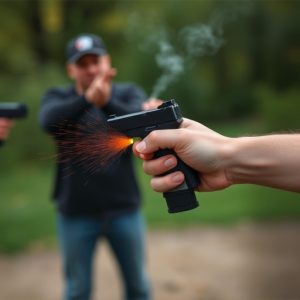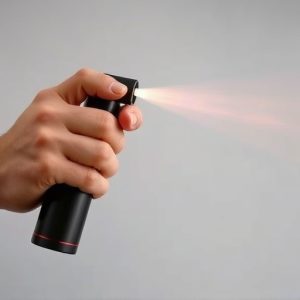Defensive Spray: Safety, Legalities, and Effectiveness for Civilian Protection
Pepper spray, a legal self-defense tool with varying US state regulations, temporarily disables atta…….
Pepper spray, a legal self-defense tool with varying US state regulations, temporarily disables attackers through capsaicin, an ingredient from chili peppers. Its effects are temporary, lasting 10-15 minutes, and can be neutralized by washing the face. Safe usage involves understanding manufacturer instructions, staying calm during encounters, targeting sensitive areas, using short bursts, and immediately washing after exposure to mitigate side effects like eye irritation or difficulty breathing. Adhering to legal guidelines and best practices ensures safe and effective use of pepper spray for self-defense.
“Defensive spray has emerged as a powerful tool for civilian protection, offering a non-lethal means of neutralizing potential threats. This compact self-defense mechanism is designed to incapacitate an aggressor temporarily, providing users with precious time to escape dangerous situations. In this comprehensive guide, we’ll explore the science behind pepper spray, its legal status for civilian use, and essential best practices for safe handling and application, focusing on effective neutralization techniques.”
- Understanding Pepper Spray: Composition and Effectiveness
- Legal Considerations for Civilian Use of Pepper Spray
- Best Practices for Handling and Using Defensive Spray Safely
Understanding Pepper Spray: Composition and Effectiveness
Pepper spray, a popular civilian protection tool, is designed to neutralize and disable an attacker temporarily. Its active ingredient, capsaicin, is derived from chili peppers and is known for its irritant properties. When sprayed into the eyes and face, it induces a burning sensation, reduced visibility, and temporary muscle immobilization. This disruption allows users to escape or defend themselves until help arrives.
The effectiveness of pepper spray lies in its ability to create a significant enough distraction without causing permanent harm. Modern formulations have improved, offering longer-lasting effects and better penetration, making them more reliable for self-defense scenarios. Understanding how these sprays work is crucial when considering their use as a last line of defense, especially for neutralizing pepper spray on the face, which remains a primary concern for users aiming to protect themselves in potentially dangerous situations.
Legal Considerations for Civilian Use of Pepper Spray
The civilian use of pepper spray for self-defense is a complex issue with significant legal ramifications. While many states in the US allow individuals to carry and use pepper spray for personal protection, there are strict regulations in place to ensure its responsible use. These laws vary by jurisdiction but generally include age restrictions, requirement for proper training, and specific scenarios under which it can be deployed legally. For example, some areas permit the use of pepper spray only as a last resort when all other means of escape or de-escalation have been exhausted.
One crucial consideration is the neutralization of pepper spray on the face. Pepper spray is designed to cause pain and temporary blindness, aiming to disable an attacker long enough for a victim to escape. However, it’s essential to understand that these effects are not permanent. The active ingredient in pepper spray, capsaicin, can be washed away with water after several minutes, and vision typically returns within 10-15 minutes. Legal cases have established that the responsible use of pepper spray, when justified by an imminent threat, can be considered self-defense, but it’s up to individuals to ensure they act within the confines of the law to avoid potential prosecution.
Best Practices for Handling and Using Defensive Spray Safely
When it comes to defensive spray, safety is paramount. To effectively neutralize pepper spray on face and maintain your well-being, follow these best practices. Always read and understand the instructions provided by the manufacturer before use. Store your spray in a secure, controlled environment, out of reach of children or unauthorized individuals. Keep it charged and regularly test the functionality to ensure it’s ready when needed.
During an encounter, remain calm and assess the situation. If possible, create distance from the attacker. Aim for the face, eyes, nose, and mouth – these are the sensitive areas pepper spray targets. Use a quick, short burst rather than prolonged spraying to minimize exposure. After use, immediately wash your face with soap and water to neutralize any residual spray. Seek medical attention if needed, especially for eye irritation or difficulty breathing.
Defensive spray can be a valuable tool for civilian self-protection, but it must be used responsibly. By understanding its composition, legal considerations, and best practices, individuals can effectively deploy this technology to neutralize pepper spray on the face while ensuring safety and legality. Remember, knowledge is power when it comes to personal protection.


